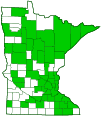Milk-white Toothed Polypore
(Irpex lacteus)
Conservation • Description • Habitat • Ecology • Distribution • Taxonomy
Conservation Status |
|||
| IUCN Red List | not listed |
||
| NatureServe | not listed |
||
| Minnesota | not listed |
||
Description |
Milk-white Toothed Polypore is widespread in Europe and North America. It is very common in the eastern United States to the Midwest, including Minnesota, but rare in the Southwest. It grows flat (resupinate) on the bottom and sides of logs and fallen branches of hardwood trees, infrequently also on conifers. It usually obtains its nutrients from dead wood (saprobic), possibly also from live cherry wood (parasitic). It is exceptionally resistant to pollution toxicity. The fruiting body is a patch of pore surface spread out flat (effused) on a branch or log (substrate). It is dry, stiff, and white, off-white, or cream-colored. Adjacent patches often fuse together creating a long row. There are 2 or 3 pores every thirty-second of an inch (1 mm). The pore walls are thin and disintegrate unevenly. As the walls break down the spore surface becomes maze-like. Eventually, only flattened, tooth-like projections less than ¼″ (6 mm) long remain. When growing on the side of a log or branch it may develop shelf-like caps. If present, the cap is ⅜″ to 1½″ wide, whitish to grayish, often concentrically zoned, and densely covered with velvety hairs. There is no stem. The flesh is thin and tough. It is not edible. |
Similar Species |
Habitat and Hosts |
Dead hardwood logs and branches |
Ecology |
Season |
Annual but persists year-round |
Distribution |
||
|
Sources Biodiversity occurrence data published by: Minnesota Biodiversity Atlas (accessed through the Minnesota Biodiversity Atlas Portal, bellatlas.umn.edu, XX/XX/XXXX). |
|
| 3/5/2025 | ||
Occurrence |
||
Widespread and very common |
||
Taxonomy |
|
| Kingdom | Fungi (Fungi) |
| Subkingdom | Dikarya |
| Phylum | Basidiomycota (Basidiomycete Fungi) |
| Subphylum | Agaricomycotina (Higher Basidiomycetes) |
| Class | Agaricomycetes (Mushrooms, Bracket Fungi, Puffballs, and Allies) |
| Subclass | incertae sedis (uncertain placement) |
| Order | Polyporales (shelf fungi) |
| Family | Irpicaceae |
| Genus | Irpex |
Family |
|
Subordinate Taxa |
|
|
|
Synonyms |
|
Boletus cinerascens Boletus tulipiferae Coriolus lacteus Coriolus tulipiferae Daedalea diabolica Hirschioporus lacteus Hydnum lacteum Irpex bresadolae Irpex diabolicus Irpex hirsutus Irpex lacteus Irpex pallescens Irpex sinuosus Irpiciporus lacteus Irpiciporus tulipiferae Microporus chartaceus Microporus cinerascens Polyporus chartaceus Polyporus tulipiferae Polystictus bresadolae Polystictus chartaceus Polystictus cinerascens Polystictus cinerescens Polystictus tulipiferae Poria cincinnati Poria tulipiferae Sistotrema lacteum Steccherinum lacteum Trametes lactea Xylodon bresadolae Xylodon hirsutus Xylodon lacteus Xylodon pallescens Xylodon sinuosus |
|
Common Names |
|
Milk-white Toothed Polypore |
|
Glossary
Resupinate
In fungi: referring to the fruiting body lying flat on the surface of the substrate, without a stalk or a cap.
Saprobic
A term often used for saprotrophic fungi. Referring to fungi that obtain their nutrients from decayed organic matter.
Visitor Photos |
Share your photo of this fungus. |
||
This button not working for you? |
||
Luciearl |
||
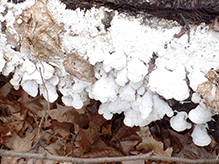 |
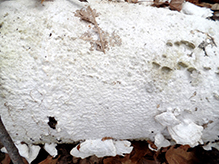 |
|
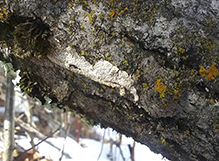 |
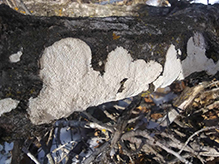 |
|
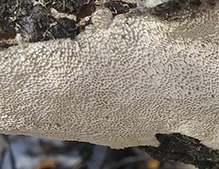 |
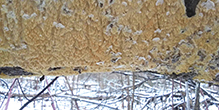 |
|
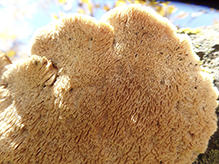 |
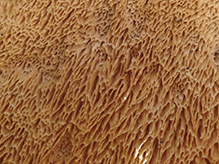 |
|
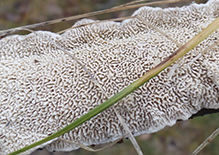 |
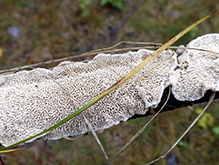 |
|
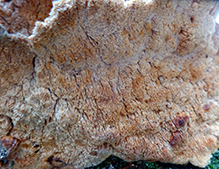 |
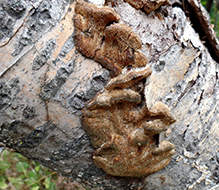 |
|
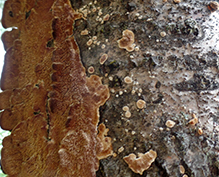 |
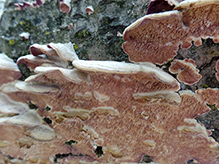 |
|
boxenfield@gmail.com |
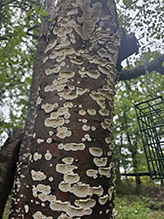 |
MinnesotaSeasons.com Photos |
|

Slideshows |
Irpex lacteus |
About
Album description Irpex lacteus (Fr.; Fr.) Fr. Elench. Fung. p145, 1828, syn.: Sistotrema lacteum Fr. Dat.: Feb. 23. 2014 and Dat.: Feb. 27. 2014 Habitat: alpine valley, an opening in mixed forest with predominantly Fagus sylvatica followed by Picea abies; modestly inclined southeast oriented mountain slope, overgrown calcareous ground composed of scree, rocks and boulders; mostly in shade, partly protected from direct rain by tree canopies; average precipitations ~ 3.000 mm/year, average temperature 7-9 deg C, elevation 560 m (1.950 feet), alpine phytogeographical region. Substratum: cut down trunk of Fagus sylvatica lying on ground, in its late initial phase of integration; the trunk was massively infected also with Trametes hirsutum. Place: Lower Trenta valley, between villages Soča and Trenta, right bank of river Soča, near 'Na melu' place, East Julian Alps, Posočje, Slovenia EC. Comments: fruit body mostly resupinated but also effused-reflexed; very large, about 1.5 m x 20 cm, about 2-3 mm thick, context thinner than pore layer; small 'pilei' up to 8(12) mm off the substrate; hymenophore with initially distinctly irregular angular, almost labyrinthine pores soon becomes irpiciform to hydnoid (compare Figs. 8. and 10.); smell indistinctive, taste initially indistinctive, after some time slightly unpleasant; 5% KOH reaction on context and pore layer mild, color changed to somewhat darker ocher-beige; SP abundant, white-yellowish with a slight green tint, oac014. No hypha clamps have been observed. All observed traits fit well to expectations for Irpex lacteus except cystidia. The fact that I haven't found conspicuously encrusted cystidia puzzles me. Spores smooth. Dimensions: 5.1 [5.9 ; 6.2] 7.1 x 2.5 [2.8 ; 2.9] 3.2 microns, Q = 1.9 [2.1 ; 2.2] 2.4; N = 47; C = 95%; Me = 6.1 x 2.8 microns; Qe = 2.2. Basidia dimensions approximately 20 x 4.5 microns.Olympus CH20, NEA 100x/1.25, magnification 1.000 x, oil, in water (spores) and NEA 40x/0.65, magnification 400x, in water, congo red (hymenium, cystidia). AmScope MA500 digital camera. Herbarium: Mycotheca and lichen herbarium (LJU-Li) of Slovenian Forestry Institute, Večna pot 2, Ljubljana, Index Herbariorum LJF Ref.: |

Visitor Videos |
Share your video of this fungus. |
||
This button not working for you? |
||
|
Other Videos |
|

Visitor Sightings |
Report a sighting of this fungus. |
||
This button not working for you? |
||
MinnesotaSeasons.com Sightings |

|
Created: 10/15/2019 Last Updated: © MinnesotaSeasons.com. All rights reserved. |
